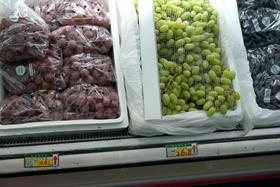
Looking back on the Australian grape season now wrapping up, the message from both sides of the trade is that the supplier needs to take a careful approach to its Asian markets.
Australia’s table grape share in its traditional Asian markets has steadily eroded since its height in the 1990s because of the increasing low-priced competition from South Africa and South America.
This has of course left quality as Australia’s key competitive edge, and keeping a tight rein on this is central to maintaining markets in South East Asia and developing new markets such as mainland China.
Vietnam is another growing market for Australian grapes, and while it ran quite well this season, it is not a forgiving market for off-specification fruit.
“This Australian grape season in 2012 was much improved in both quality and volume for Red Globes, though the Autumn Royal and Black Globe were not good quality and had a mixed purple colour,” explained Pham Minh Nghia of Vietnamese import broker NC Group.
A similar situation was luckily not duplicated in the newly developing Chinese mainland market.
“In my view growers were more careful in what they selected and packed for China this year, and this led to more price stability in the market,” stated David Minnis of Australian grower-exporter M&A Exports. “This trend needs to continue for Australia to grow the market.”
The other challenge in the Chinese market is avoiding the pitfall that South American suppliers have been facing there in recent years. Coordinating sendings to dodge oversupply is a tricky task, but it’s one Minnis believes is critical to getting the return Australia needs from the market.
“The key question that the trade, and all importers in Jiangnan Market, need to address in my opinion is how can they cooperate in such a way that the market is not oversupplied on any one day with Australian Crimson Seedless,” he says.
“This is one of the premium varieties on the market when the sugar levels are right, like this season, but when 20 containers are put on the market on one day, the price drops Yn30-40 or A$5-6 per carton and the grower/exporter pays. This happened in April this past season.”
Minnis says Australia needs to be more strategic about how its fruit is marketed. That strategy will probably continue to rely on the wholesale market system, as China’s supermarket chains’ unwillingness to pay for premium fruit mean retail programmes are unlikely to be a solution.
Despite those challenges, the Australian grape trade to China looks promising to many in the industry.
“There has been an increase in fruit going directly to China,” says Dino Garreffa of Australian grape grower Tabletop Grapes. “I think that a lot of growers will register next season to go direct after seeing the results of going direct this season.”



